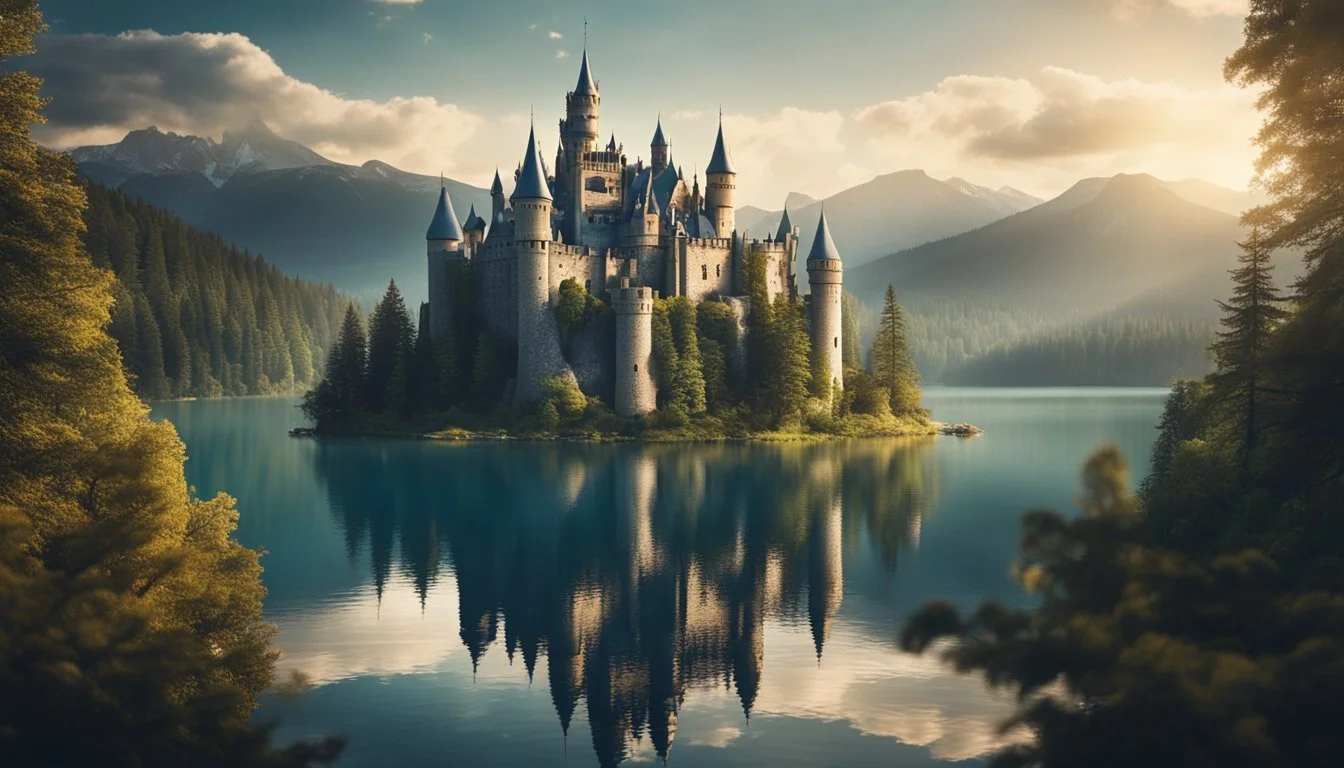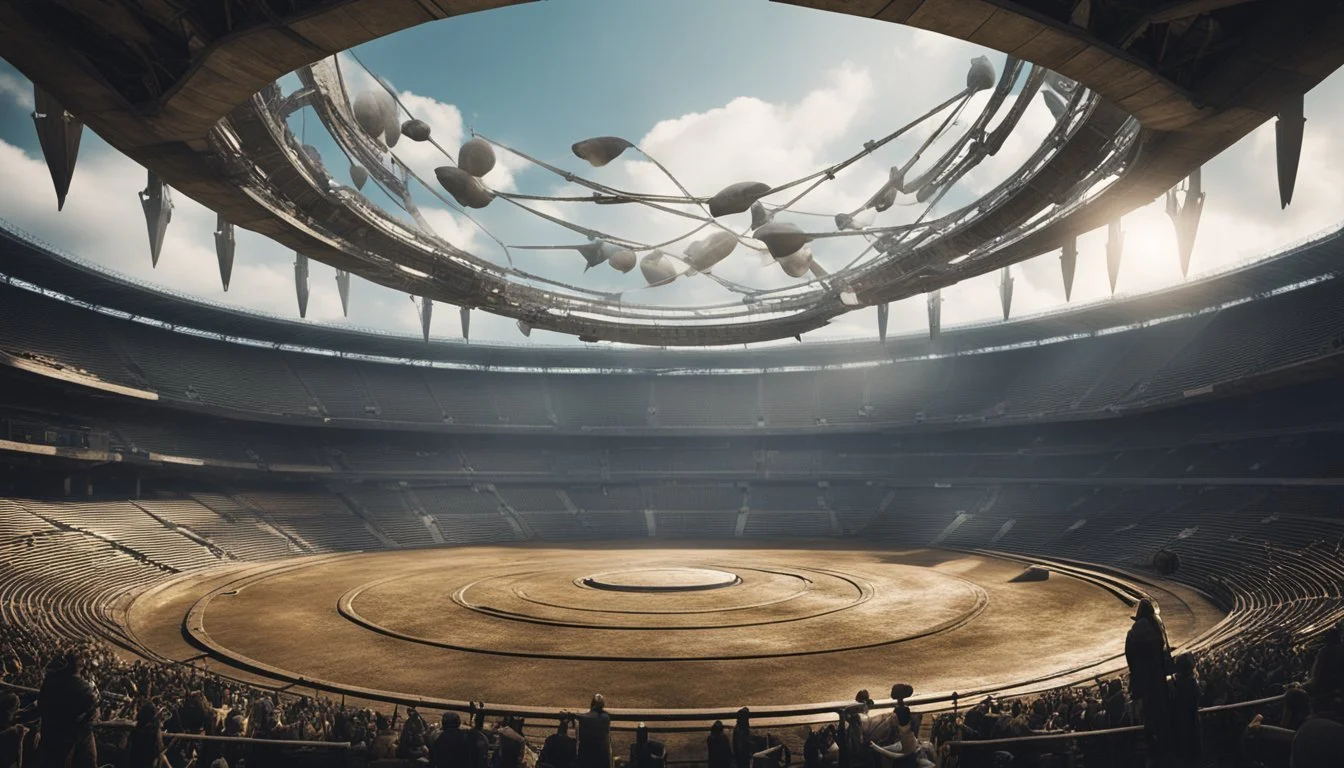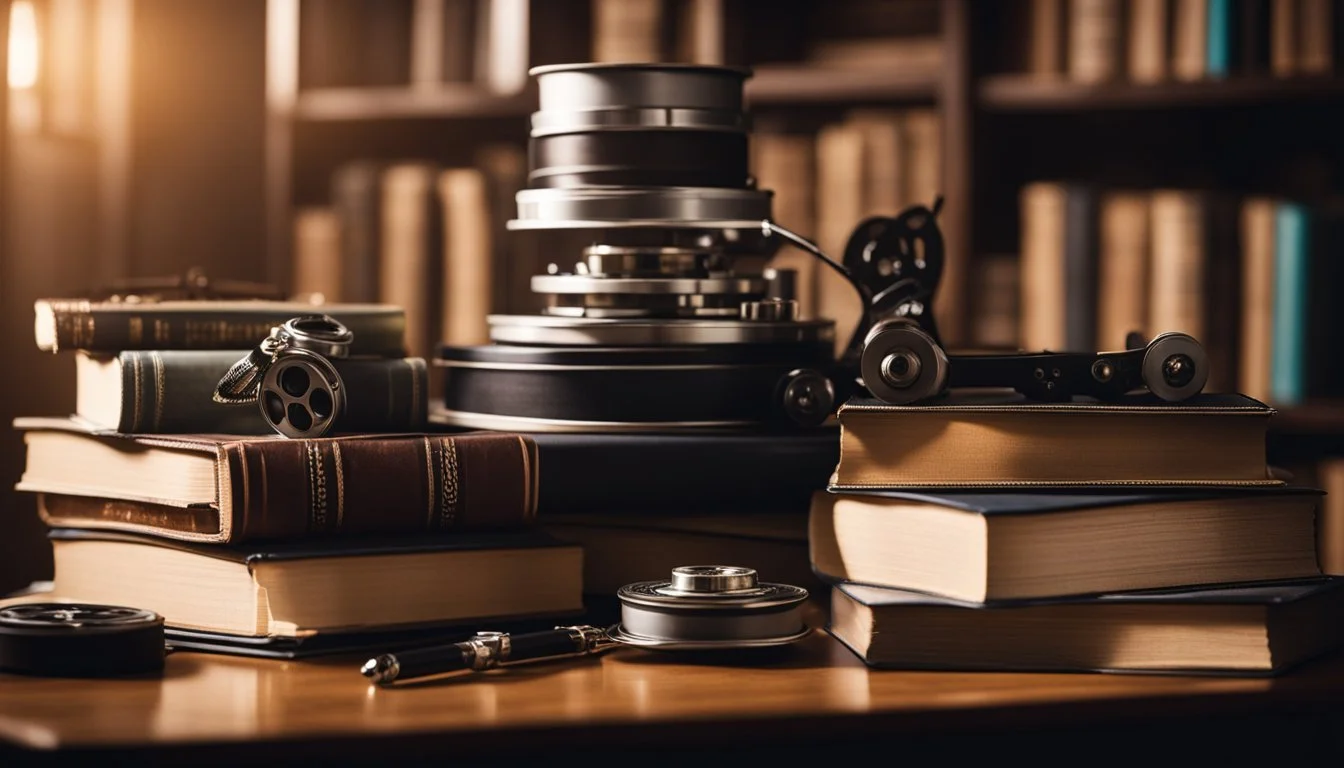12 Documentaries About Literary Adaptations in Film
Exploring Page to Screen Transformations
Literary adaptations have long been a staple in the film industry, transforming beloved and iconic books into cinematic masterpieces. These adaptations not only bring stories to a broader audience but also offer fresh perspectives and new interpretations of classic literature.
This article explores 12 documentaries that dive deep into the nuances and challenges of adapting literary works into films, examining how filmmakers balance staying true to the source material with the demands of visual storytelling. Through these documentaries, viewers gain insights into the intricate process of translating words on a page into compelling scenes on the big screen.
1) Atonement - Ian McEwan (2007)
Adapted from Ian McEwan’s 2001 novel, "Atonement" is a film that explores themes of love, guilt, and the reality of consequences. Directed by Joe Wright, the film meticulously translates the book’s rich narrative and complex characters onto the screen.
The story starts in 1935 at the estate of the Tallis family. 13-year-old Briony Tallis falsely accuses Robbie Turner, the housekeeper's son, of a crime he didn’t commit, setting off a chain of events that affects multiple lives.
Keira Knightley stars as Cecilia Tallis, and James McAvoy portrays Robbie Turner. Their performances capture the emotional depth required for the adaptation. The film spans several decades, moving from pre-World War II England to the tumult of war and its aftermath.
The adaptation of "Atonement" received critical acclaim, praised for its faithfulness to McEwan’s narrative and its visual storytelling. The film’s impressive cinematography, including the iconic five-minute Dunkirk beach scene, also earned it accolades.
For more information on the film and its adaptation process, visit the Wikipedia page.
2) The Great Gatsby - F. Scott Fitzgerald
F. Scott Fitzgerald's "The Great Gatsby" has inspired multiple film adaptations over the years, each bringing a unique interpretation to the classic novel.
The 1974 adaptation, directed by Jack Clayton, starred Robert Redford as Jay Gatsby and Mia Farrow as Daisy Buchanan. Francis Ford Coppola wrote the screenplay for this film right after working on "The Godfather." IMDB
In 2013, Baz Luhrmann directed a vibrant and visually stunning adaptation featuring Leonardo DiCaprio as Gatsby and Carey Mulligan as Daisy. The film was noted for its modern soundtrack and lavish production design. IMDB
There was also a 1949 version, less widely known, directed by Elliott Nugent with Alan Ladd playing Gatsby. This film is often a point of curiosity for die-hard fans of the novel. IMDB
A unique reimagining came in 2002 with "G," which placed the story in the context of the early 2000s hip-hop scene. Directed by Christopher Scott Cherot, it starred Richard T. Jones as the enigmatic Summer G. IMDB
Each film adaptation of "The Great Gatsby" brings a different lens to the tale of love, wealth, and tragedy, showcasing the timeless allure of Fitzgerald's story.
3) Pride & Prejudice - Jane Austen
Jane Austen's "Pride and Prejudice" has inspired numerous film and television adaptations, each providing a unique take on the beloved novel.
The 1940 adaptation directed by Robert Z. Leonard presents a Hollywood take on the story, starring Greer Garson and Laurence Olivier. This version is known for its lavish costumes and set design. IMDB
The 1995 BBC miniseries offers a faithful rendition of Austen's work. Starring Colin Firth and Jennifer Ehle, it has become iconic, especially for Firth's portrayal of Mr. Darcy. IMDB
Joe Wright's 2005 film adaptation stars Keira Knightley and Matthew Macfadyen. This version is notable for its beautiful cinematography and a more modern, emotionally-driven approach to the characters. IMDB
"Pride and Prejudice" (2003) provides a contemporary twist by setting the story in modern-day Utah. This adaptation takes creative liberties but retains the essence of Austen’s themes. IMDB
For a different flavor, "Pride and Prejudice and Zombies" (2016) combines the classic story with a fantastical zombie plot. It’s based on the 2009 book of the same name by Seth Grahame-Smith. IMDB
4) To Kill a Mockingbird - Harper Lee
The 1962 film adaptation of "To Kill a Mockingbird" is a noteworthy portrayal of Harper Lee's acclaimed novel. Directed by Robert Mulligan, the movie captures the essence of the book's themes and characters with remarkable fidelity.
The story is set in the Depression-era South and follows lawyer Atticus Finch as he defends an African American man falsely accused of raping a white woman. Gregory Peck's portrayal of Finch is widely celebrated, earning him an Academy Award for Best Actor.
Harper Lee's narrative explores profound themes of racial injustice and moral growth. The relationship between Scout, Finch's young daughter, and their enigmatic neighbor, Boo Radley, adds depth to the story. This dynamic is effectively translated to the screen, maintaining the novel’s emotional impact.
"To Kill a Mockingbird" remains a cultural touchstone, often discussed in the context of American literature and film adaptation. For more detailed information on the 1962 film, visit the IMDB page.
5) The Lord of the Rings - J.R.R. Tolkien (2001-2003)
The adaptation of J.R.R. Tolkien's "The Lord of the Rings" is one of cinema's most ambitious projects. Directed by Peter Jackson, the film series was released in three parts: "The Fellowship of the Ring" (2001), "The Two Towers" (2002), and "The Return of the King" (2003).
Jackson meticulously brought Tolkien's Middle-earth to the screen. Using cutting-edge special effects, detailed set designs, and a committed cast, the films successfully captured the essence of the novel's epic narrative.
The series is known for its faithful portrayal of the story's central themes of friendship, courage, and sacrifice. With a runtime of over 11 hours across the three films, it offers a comprehensive visual representation of Tolkien's world.
The adaptation won numerous awards, including multiple Academy Awards, and it holds a significant place in the hearts of both fans of the books and newcomers alike. It stands as a benchmark for high-fantasy film adaptations, exemplifying how literature can be transformed into a visual spectacle.
For more information on the films, visit The Lord of the Rings (film series) on Wikipedia.
6) Harry Potter Series - J.K. Rowling
The Harry Potter film series, based on J.K. Rowling's acclaimed book series, remains one of the most successful literary adaptations in film history.
The series, beginning with "Harry Potter and the Philosopher's Stone" (2001), captured the imagination of audiences worldwide and set new standards for fantasy filmmaking.
Directed by Chris Columbus, the first film introduced viewers to the magical world of Hogwarts and the journey of a young wizard named Harry Potter.
Subsequent films, including "Harry Potter and the Chamber of Secrets" (2002) and "Harry Potter and the Prisoner of Azkaban" (2004), continued to build the rich, intricate world Rowling created.
Each installment delves deeper into Harry's battles against the dark wizard, Voldemort, and explores themes of friendship, bravery, and sacrifice.
The films benefited from strong performances by a talented cast, including Daniel Radcliffe, Emma Watson, and Rupert Grint.
Moreover, the series maintained a consistent tone, visual style, and attention to detail, which helped it resonate with both fans of the books and new audiences.
The final book, "Harry Potter and the Deathly Hallows," was split into two films, released in 2010 and 2011, concluding the epic saga on a high note.
This film series not only brought J.K. Rowling's intricate world to life but also left an indelible mark on popular culture. Harry Potter Series - Wikipedia
7) The Shining - Stephen King (1980)
Stanley Kubrick’s film adaptation of Stephen King's novel "The Shining" has sparked much discussion among fans and critics. When Kubrick received the manuscript in 1976, he saw a great opportunity to turn it into a cinematic masterpiece.
Kubrick's vision significantly diverged from the source material. King’s novel focuses on the descent of Jack Torrance into madness. Kubrick, however, emphasized atmospheric horror and utilized a more ambiguous narrative technique.
Stephen King expressed dissatisfaction with Kubrick's adaptation, feeling it stripped away much of the book's nuanced storytelling. Despite this, "The Shining" has become a cult classic and is widely analyzed for its intricate film-making techniques and chilling atmosphere.
The film’s differences from the novel have fueled numerous theories and interpretations over the years. These are explored in the documentary "Room 237," which presents various fan theories about the hidden meanings in Kubrick's film.
For more information on the film adaptation, visit Wikipedia.
8) Fight Club - Chuck Palahniuk (1999)
"Fight Club," directed by David Fincher, is a seminal film from 1999. The movie is an adaptation of Chuck Palahniuk's novel, which delves into the psyche of its disillusioned narrator. The narrative explores themes of toxic masculinity and societal dissatisfaction.
Brad Pitt and Edward Norton deliver compelling performances, bringing the complex characters of Tyler Durden and the unnamed narrator to life. The film captures the spirit of the book while adding its own cinematic flair. Helena Bonham Carter's portrayal of Marla Singer adds depth to the story's interpersonal dynamics.
David Fincher skillfully translates Palahniuk's dark humor and anti-establishment sentiments to the screen. The aesthetics of the film, combined with its narrative, create a visually and thematically rich experience. The movie’s gritty and anarchic tone resonates with audiences even decades after its release.
Jim Uhls penned the screenplay, staying true to the book's core while making necessary adjustments for the cinematic medium. The collaboration between Fincher, Pitt, Norton, and Carter was pivotal in making "Fight Club" an enduring classic.
For more information about the film, visit Wikipedia.
9) The Hunger Games - Suzanne Collins
"The Hunger Games" (2012) is the film adaptation of Suzanne Collins' best-selling novel of the same name. Directed by Gary Ross, the movie is set in a dystopian future where 24 youths are chosen to participate in a televised death match.
Jennifer Lawrence stars as Katniss Everdeen, the protagonist who volunteers to take her sister's place in the games. The film captures the intense and brutal nature of the competition, staying true to the book’s grim and gripping tone.
The story delves deeply into themes of sacrifice, survival, and the impacts of authoritarian regimes. Collins' narrative explores how societies can become desensitized to violence and the lengths individuals will go to protect their loved ones.
The movie grossed over $694 million globally, becoming a cultural phenomenon and spawning three successful sequels. It received praise for its strong performances, particularly Jennifer Lawrence's portrayal of Katniss, and its faithful adaptation of the source material.
For more information on "The Hunger Games" (2012), visit IMDb.
10) Life of Pi - Yann Martel (2012)
"Life of Pi," directed by Ang Lee, is a film adaptation of Yann Martel's 2001 novel. The story follows Pi Patel, a young man stranded in the Pacific Ocean with a Bengal tiger, among other animals.
The film faced significant challenges in its production. Critics initially labeled the novel as "unfilmable" due to its complex narrative and heavy reliance on CGI to depict the animals and vast ocean scenes.
Ang Lee's adaptation of "Life of Pi" is visually stunning, capturing the essence of Pi's spiritual and physical journey. The film uses groundbreaking visual effects to create a realistic portrayal of the ocean and the animals residing in it.
This adaptation is not just a survival story; it explores themes of faith, resilience, and the human condition. The cinematography and visual storytelling keep the audience engaged, making it a successful translation from page to screen.
The cast includes Suraj Sharma as the young Pi Patel and Irrfan Khan as the adult Pi. The film has been praised for its compelling visuals and thought-provoking narrative.
For more information, visit the IMDb page.
11) The Shawshank Redemption - Stephen King (1994)
"The Shawshank Redemption," directed by Frank Darabont, is a cinematic adaptation of Stephen King's novella "Rita Hayworth and Shawshank Redemption." Released in 1994, this prison drama has garnered significant acclaim.
The story centers on banker Andy Dufresne, wrongfully convicted of murdering his wife and her lover. Andy's resilience and hope make for a compelling narrative.
Morgan Freeman stars as Ellis "Red" Redding, a lifer who becomes close friends with Andy. His distinctive voice provides narrations that add depth to the film.
Darabont's adaptation captures the essence of King's work, portraying themes of friendship, hope, and redemption. The film's accurate portrayal of prison life has been widely praised.
The Warden, Samuel Norton, exemplifies corruption and abuse of power in the prison system. Both the book and film depict his exploitation of the inmates vividly.
While King’s novella is gripping, Darabont's adaptation brings the story to life in a different way, making "The Shawshank Redemption" a classic in film history. The film was nominated for seven Academy Awards.
For more details, visit Wikipedia.
12) Gone Girl - Gillian Flynn (2014)
"Gone Girl," adapted from the bestselling novel by Gillian Flynn, is a gripping exploration of marriage, deception, and media sensationalism. David Fincher directed the 2014 film, bringing his distinctive style to the dark narrative.
Gillian Flynn's involvement in the adaptation process was significant. She wrote the screenplay herself, ensuring that the film maintained the same intricate storytelling and psychological tension as the book.
The film features Ben Affleck and Rosamund Pike in lead roles, delivering performances that capture the complexities of the characters. Rosamund Pike’s portrayal of Amy Dunne earned her critical acclaim and several award nominations.
The narrative structure of the film closely mirrors the book, using dual perspectives and unreliable narration to keep the audience in suspense. The adaptation’s success lies in its ability to retain the novel’s shocking twists and turns while making it compelling for a visual medium.
Gone Girl's film adaptation has sparked discussions about fidelity to source material and the dynamics of translating complex novels into movies. The adaptation has been praised for its faithfulness to the tone and essence of Flynn's original work.
For more information about the film adaptation of "Gone Girl," visit IMDB.
The Art of Literary Adaptations
Adapting a beloved book into a successful film requires a nuanced approach, balancing fidelity to the source material with the needs of the cinematic medium. This process is both a creative challenge and a practical endeavor, presenting specific obstacles and opportunities.
Understanding the Process
The first step in adapting a literary work into a film involves a careful reading of the source material. Filmmakers must discern the core themes, character arcs, and key plot points that define the book. They then transform these elements into a screenplay, which requires a deep understanding of both the narrative and the visual storytelling techniques unique to cinema.
Collaboration is essential. Writers, directors, and producers must work together to integrate their visions while respecting the original text. Casting decisions also play a crucial role in this process, as actors must embody the spirit of literary characters. For instance, Jennifer Lawrence’s portrayal of Ree in "Winter's Bone" exemplifies a seamless transition from page to screen.
Challenges and Considerations
One of the main challenges is condensing a book's extensive content into a two-hour film. This often means omitting subplots and secondary characters, which can upset purists. For example, Peter Jackson’s adaptation of "The Lord of the Rings" selectively trimmed Tolkien's extensive descriptions to focus on the central journey.
Maintaining the book's essence while making necessary changes for cinematic appeal is another critical consideration. The filmmaker must ensure the movie remains true to the book’s spirit, even when certain narrative elements are altered or omitted. This delicate balance requires thoughtful decision-making and a deep respect for the original work.
Filmmakers also face technical challenges, such as visualizing complex scenes and creating special effects, which must align with audience expectations and novel descriptions. Moreover, financial constraints and production timelines can influence creative decisions, making the adaptation process even more intricate.
Key Elements of Successful Adaptations
Achieving a successful literary adaptation involves capturing the core essence of the source material while balancing it with creative cinematic elements. The following sections explore these critical aspects in detail.
Maintaining the Source Material's Essence
One of the most important aspects of any adaptation is maintaining the source material's essence. This refers to staying true to the key themes, characters, and overall tone of the original work. Consistency is vital, as audiences often have strong attachments to the source material.
For example, Gone Girl by Gillian Flynn, adapted into a film in 2014, remained faithful to the book's dark tone and complex characters. This helped maintain the psychological thriller's core appeal and ensured that fans of the book appreciated its translation to film.
Balancing Creativity and Fidelity
While staying true to the source material is important, a successful adaptation also requires a certain degree of creative liberty. Filmmakers must make choices that suit the cinematic medium, which sometimes means altering or omitting certain plot points or characters.
In the 1962 film adaptation of To Kill a Mockingbird, directed by Robert Mulligan, creative adjustments were necessary to fit the story into a feature-length film while capturing the essence of Harper Lee's novel. Capturing the mood and key messages while adapting specific scenes and dialogue is critical to resonate with both new viewers and existing fans of the book.
Impact of Adaptations on Literature and Film
Adaptations bridge literature and film, enriching both mediums. They promote literary works and shape cinematic trends.
Promoting Literary Works
Film adaptations often revive interest in the original literary works. Sales of books frequently increase following the release of a successful adaptation. For instance, sales of J.R.R. Tolkien's "The Lord of the Rings" spiked around the release of Peter Jackson's film trilogy.
Educational impact is another benefit. Teachers and parents leverage films to introduce children to classic literature. A student might find a Shakespeare play more approachable after watching a modern film adaptation. This synergistic relationship helps sustain the relevance of literature in modern society.
Influence on Cinematic Trends
Adaptations also influence trends in cinema. They introduce novel storytelling techniques adapted from their literary origins. For example, non-linear narratives seen in films like "Pulp Fiction" draw inspiration from literary techniques.
Moreover, major studios often bank on the pre-existing popularity of literary works, resulting in financially successful films. The "Harry Potter" and "Twilight" series are prime examples of this strategy. These adaptations define genre trends and set benchmarks for future projects.
The cross-pollination between the two art forms fosters innovative ideas, enriching the cultural landscape.










